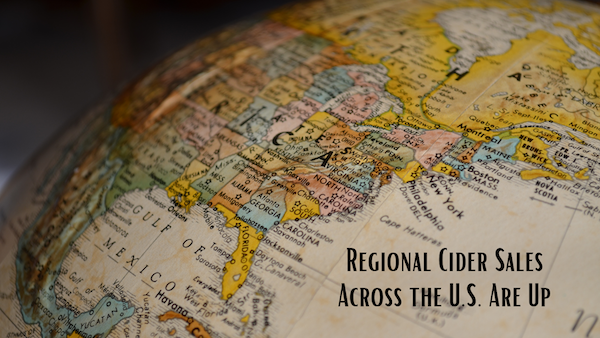Guest Blog: Regional Cider Sales Across the U.S. Are Up

With cider production up in over 30 states, is the beverage finally shedding its “fall-drink-only” status?
When rosé burst into the wine world in the mid-2000s, producers had a lot of work to do when it came to shaking off its ‘summer-drink-only’ rank. Similarly, cidermakers have faced challenges when it comes to showing consumers the drink is enjoyable all year, not just during pumpkin patch and u-pick season. (Though it’s quite lovely then, too).
But perhaps, cidermakers are starting to see their efforts pay off—literally. According to NielsenIQ, from July 2023–July 2024, regional, or independent, cider retail sales in NIQ-measured channels have reached a whopping $806.7 million, up 3.4% from the year previous. Additionally, regional cider was one of just three sub-categories to also experience volume growth in the beer-tracked category.
Naturally, you might be thinking ‘sure, but that includes fall and winter, cider’s popular seasons.’ And you would be correct. But when you break those numbers down even further and look at the past 13 weeks, regional off-premise cider sales are still up by just under 2% and have raked in approximately $217.6 million in sales.
The growth seems to be stemming from states not often associated with cider—let alone cidermaking. Big cider states like California and New York saw their sales rise by 3.8% and 1.5% respectively. But surprisingly, it was regions like Georgia saw cider sales rise 58% to $2.2 million while its production jumped 54%; Arizona saw its sales rise nearly 33% to just shy of $2 million with production up 22%; and lastly, Tennessee saw its sales spike 34.3% to just shy of $2.5 million with its production rising 28%. These states were outliers in terms of their double-digit growth. But 28 additional states also saw a rise in both their cider sales and production.
Historically, cidermakers have long-relied on their tasting rooms to drive most of their sales. And it makes sense. The American cider scene is still young (relatively speaking of course). Meaning there are still many consumers who don’t quite know what it is or harbor some pretty unfortunate preconceived notions of the drink thanks to a bottle they chugged in college. Whereas those going to a cidery likely already have, at the very least, a base-level interest. Not to mention, the person working the tasting room has the opportunity to sell consumers and to-go bottles and cans.
Yet, in the past year, regional cider brands saw their off-premise sales increase by 3.4 basis points. Meaning more consumers are scanning the shelves stocked with beers, wines, flavored malt beverages (FMB), and opting for cider instead.
Six-packs were by far the most popular format to buy cider in, claiming 48% of off-premise sales (both local and national). It’s followed by four-packs (20% of regional and national) and 12-packs (16% of regional and national). Bottle sales across local and big-name brands were down.
As for flavor profiles, the standard “apple” hard cider reigns supreme, raking in over $800 million in sales. That number is down slightly from the year previous. But perhaps it’s because there are so many additional flavors to try, running the gamut from blueberry to dragonfruit.
When it comes to experimenting with some different flavors, consumers seem a bit more willing to do so with their local cidery. For instance, regional producers saw their berry, tropical, and stone fruit cider sales jump 3.9, 12.1 and 21.8 basis points respectively. National brands, on the other hand, were down in nearly all flavor categories minus tropical and citrus. Neither of which saw a major bump in sales or production volume.
The Bigger Picture
When looking at the overall beer and FMB market, there’s no denying that cider is a small slice of the pie, it makes up about 1% of sales. And no, cider shouldn’t be compared to beer when it comes to production or flavor profile. But there are some similarities and contrasts when it comes to the rise of craft beer and what we might be starting to see with local cider.
Back in 2012, craft beer was starting to take off and accounted for about 10% of the market. In the decade-plus since, it’s fluctuated up and down. At its peak in 2021, it held 26.1% of the beer market according to Statista. Currently, NielsenIQ has it at 14% of the market.
That’s pretty remarkable when considering these small establishments are up against industry titans like Anheuser-Busch, which produces millions of barrels annually.
Similarly, when cider was growing in the mid-2000s, there were only a handful of national brands and international brands like Strongbow, owned by behemoth Heineken, widely available to the public.
But craft beer had the luxury of being a product of which Americans were quite familiar. Cider doesn’t quite have that—yet. While it may seem slow, the data indicates that is starting to change. And it starts with your local producer elevating cider so it becomes more than a “fall drink” and something people feel comfortable with taking a chance on at their local grocery store.
About the Author:
Kristen Richard is a Colorado-based writer specializing in food, drink, and the outdoors. Her work has appeared in Wine Enthusiast, where she was previously the digital editor, as well as in Backpacker, All About Beer, Thirst Colorado, and others. She specializes in covering the science and history behind food and drink.
The views, information, or opinions expressed in guest blogs are solely those of the authors involved and do not necessarily represent those of the American Cider Association.
